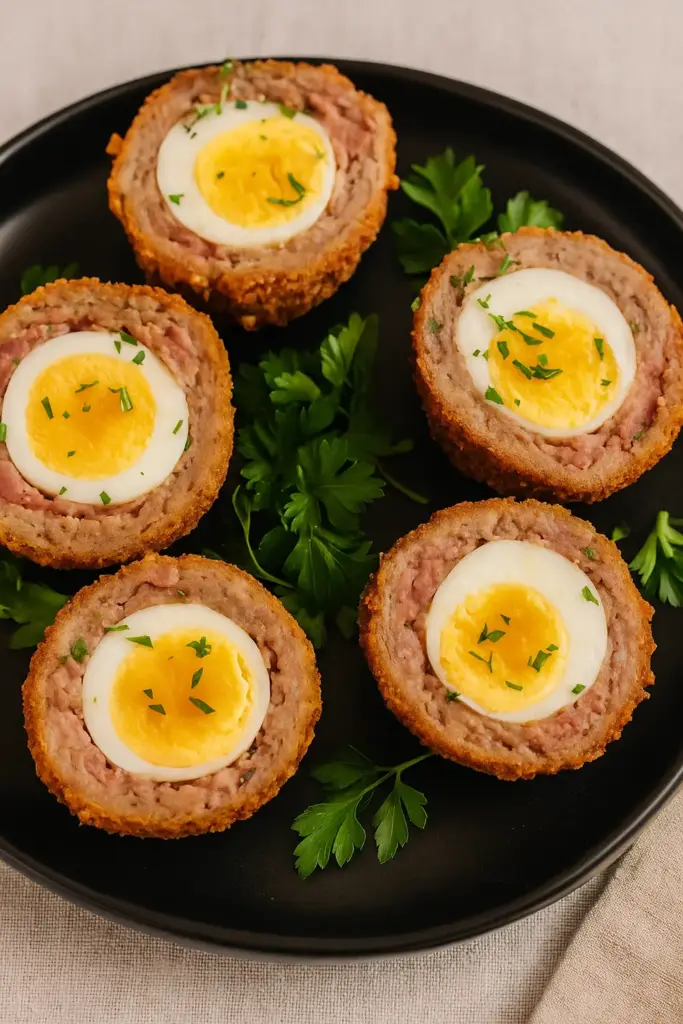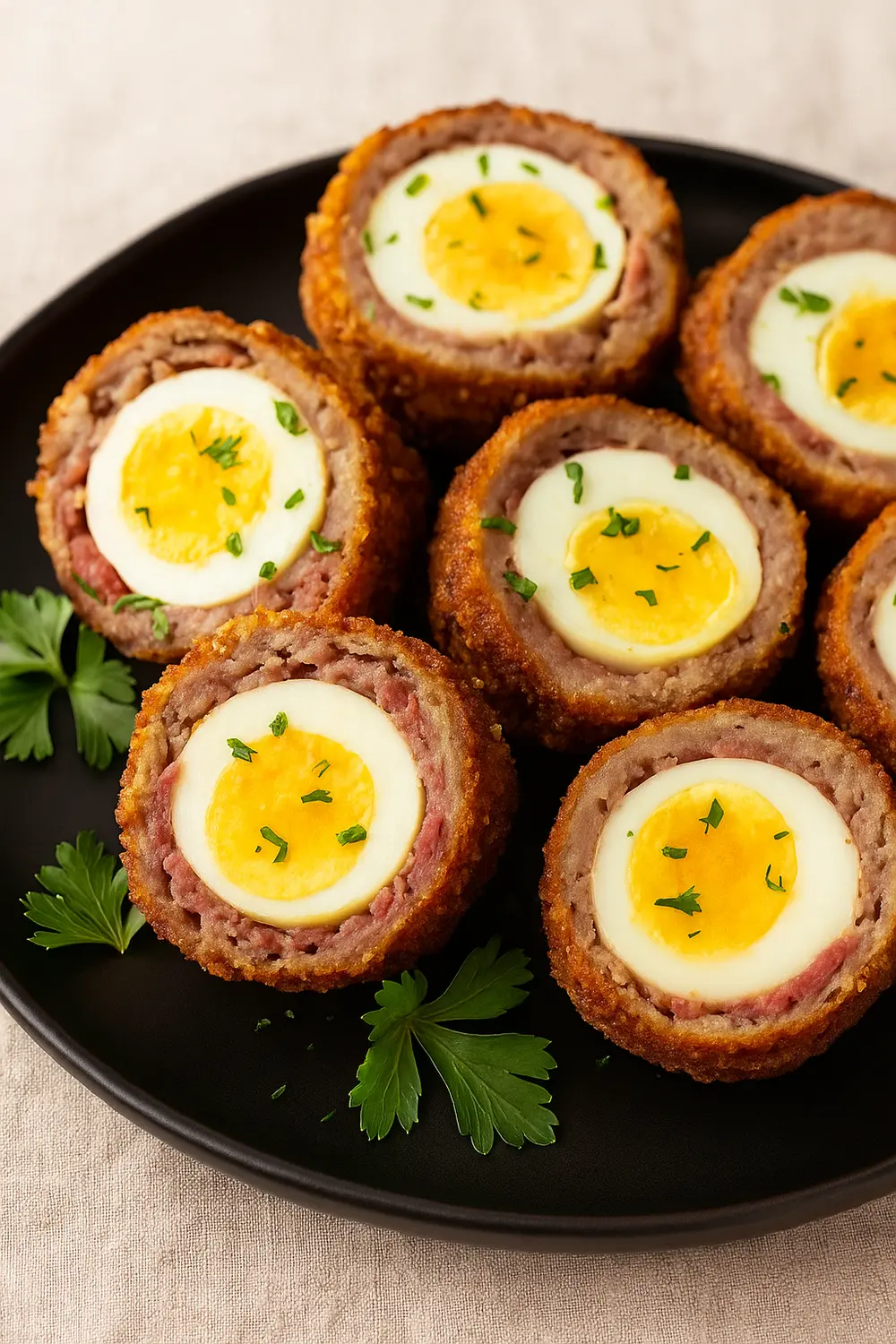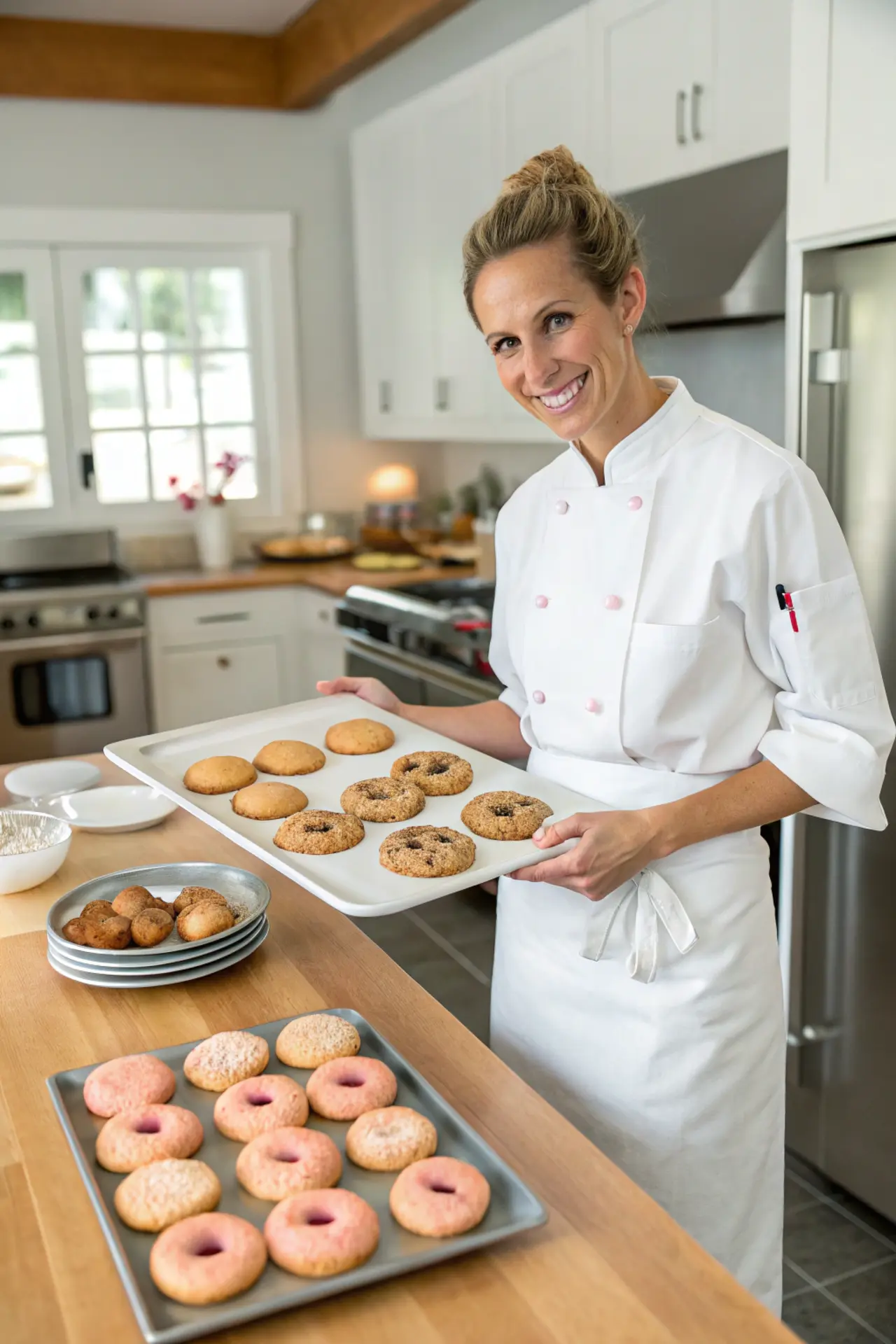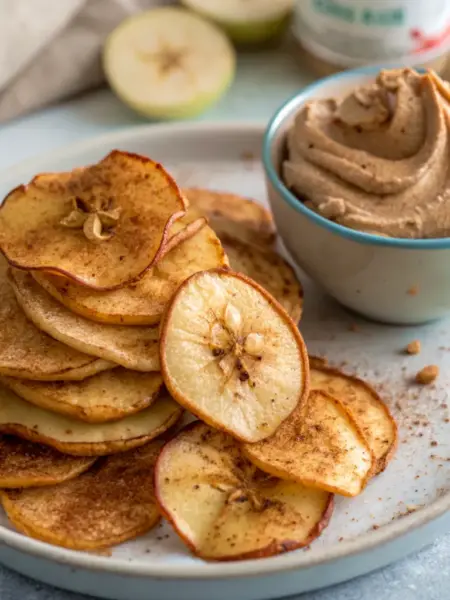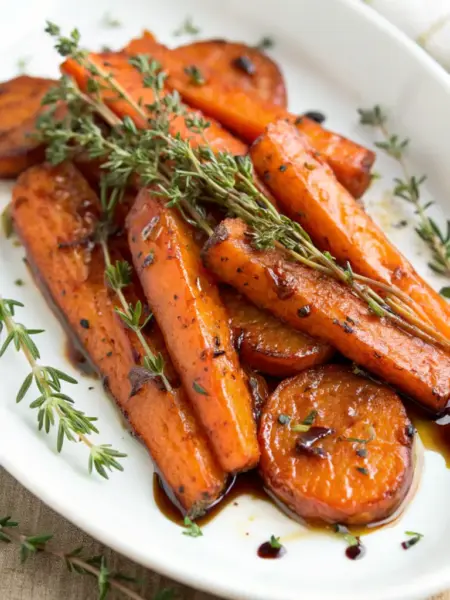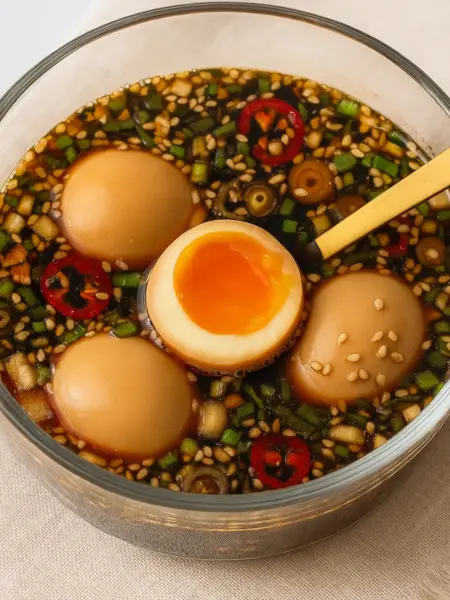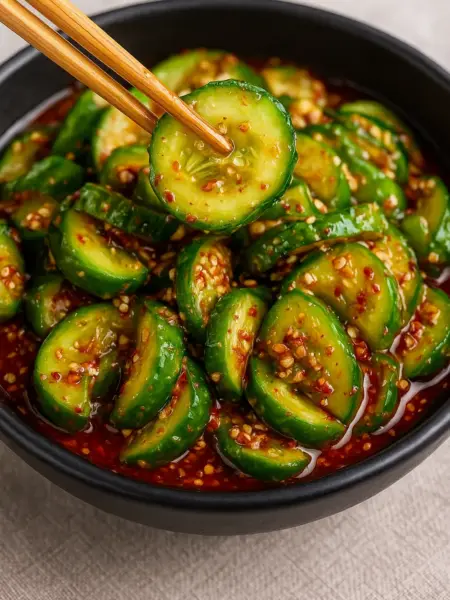This post may contain affiliate links, meaning I may earn a commission if you make a purchase, at no extra cost to you. I only recommend products I trust. Thank you for your support.
A scotch egg is a hard or soft-boiled egg wrapped in seasoned sausage meat, coated in breadcrumbs, and typically deep-fried or baked until golden and crispy. It is a popular British snack or light meal.
Despite the name, the scotch egg is not Scottish in origin, a fact that often surprises many. The “scotch” likely refers to the process of “scotching” or covering meat.
The most widely accepted theory attributes its creation to Fortnum & Mason, a renowned luxury department store in Piccadilly, London, dating back to 1738.
It was reportedly conceived as a convenient, hearty snack for wealthy travelers embarking on long coach journeys. This origin story positions it firmly within the realm of traditional English cuisine.
This easy homemade scotch eggs recipe yields 6 golden-brown and perfectly crispy scotch eggs with jammy yolks and is ideal for brunch, picnics, or a hearty snack.
Each serving (one scotch egg) clocks in around 258 calories, featuring a perfectly boiled egg wrapped in seasoned sausage, coated in crunchy breadcrumbs, and baked to crispy perfection in under 50 minutes.
We’ve also included three ways to cook these scotch eggs, whether you prefer using an air fryer, baking them in the oven, or deep-frying, so you can pick the method that suits your kitchen and how crispy you like them.
✅ Take a moment to read through the whole post first; you’ll pick up expert tips, handy equipment guides, and step-by-step details to help everything turn out perfectly. The full recipe is right below.
What You’ll Need for this Homemade Scotch Eggs Recipe
Crafting the best scotch eggs truly begins with selecting the right components. Each ingredient plays a vital role in achieving that ideal balance of flavor and texture.
1. Eggs
- While any large eggs will work, large free-range eggs offer richer, creamier yolks and better flavor.
- For easier peeling, choose large eggs that are about a week or two old rather than very fresh ones.
2. Sausage Meat
- A good quality bulk pork sausage, such as breakfast sausage, is a common and excellent choice.
- You can also use ground pork or even a blend with black pudding for a richer, more traditional British flavor.
3. Seasonings & Aromatics
- Worcestershire sauce adds a subtle tang, Dijon mustard brings a smooth heat, smoked paprika lends a warm earthiness, and fresh parsley offers a bright herbaceous note.
- Garlic powder, onion powder, dried thyme, dried oregano, salt, and black pepper deepen the savory profile.
4. Flour (All-Purpose or Almond)
- A light dusting of flour creates a slightly tacky surface that helps the sausage and breadcrumbs stick better.
- For keto scotch eggs, almond flour provides a low-carb alternative while still binding beautifully.
5. Egg Wash
- Beaten eggs serve as the adhesive between the flour and breadcrumbs, guaranteeing a uniform, crackling crust.
6. Panko Breadcrumbs
- While regular seasoned breadcrumbs can be used, Panko is highly recommended for its superior crispiness and lighter texture.
- They create that satisfying crunch that makes a Scotch egg truly special.
7. Cooking Oil
- For deep frying, a neutral oil with a high smoke point, such as vegetable, canola, or sunflower oil, is essential.
- The quantity should be sufficient to allow the eggs to be submerged, typically 3-4 inches deep.
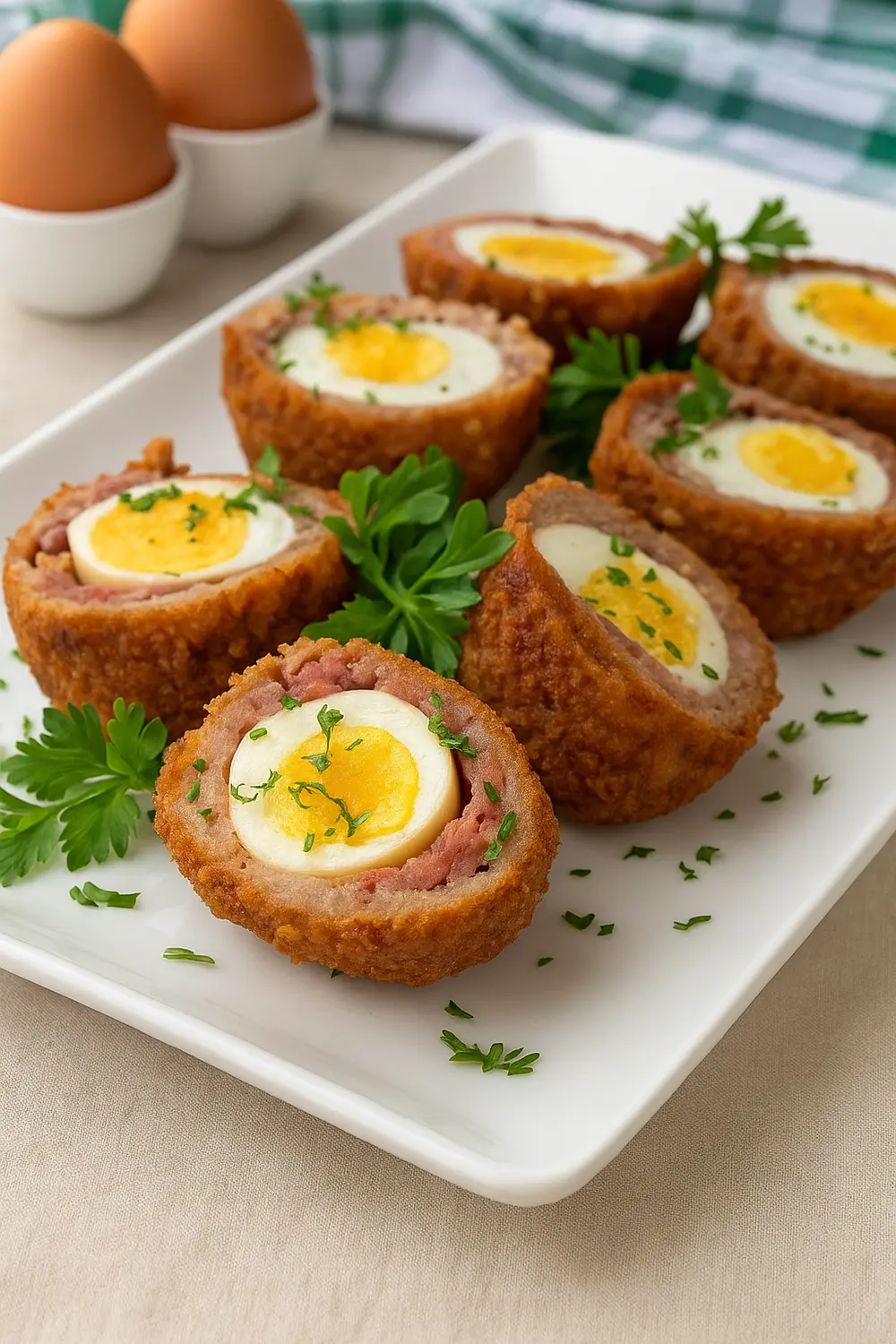
Equipment Needed for Making this Homemade Scotch Eggs Recipe
Having the right kitchen tools can make the scotch egg preparation process smoother and more efficient. The following equipment is essential for this scotch egg recipe:
- Large Pot or Saucepan: For boiling the eggs and, if deep frying, for heating the oil.
- Large Bowl: For the ice bath and for mixing the sausage meat.
- Medium Bowls or Shallow Dishes (3): For setting up the breading station (flour, egg wash, breadcrumbs).
- Spider Skimmer or Slotted Spoon: For carefully lowering and removing eggs from boiling water and hot oil.
- Wire Rack and Baking Sheet: For draining fried eggs and for baking/air frying methods.
- Instant-Read Thermometer (or Candy Thermometer): Crucial for monitoring oil temperature during frying and ensuring the internal temperature of the sausage is safe.
- Plastic Wrap: Useful for flattening sausage patties and assisting in wrapping the eggs.
- Paper Towels: For drying peeled eggs and draining excess oil from cooked scotch eggs.
- Whisk or Fork: For beating eggs for the egg wash.
- Serrated Knife: For cleanly slicing the cooked scotch eggs in half without squishing the yolk.
Why People Love Scotch Eggs
There’s something undeniably captivating about a Scotch egg that makes it a perennial favorite. People adore them for a multitude of reasons:
- Portability & Convenience: Perfect on the go, scotch eggs pack protein and flavor into a single, hand‑held treat.
- Comforting Nostalgia: With roots in traditional English tearooms and pubs, they evoke cozy afternoons and convivial gatherings.
- Flavor Meets Texture: Juicy sausage meets tender egg meets crunchy crumb, a trifecta of sensations.
- Customizable & Versatile: From classic recipes to vegetarian scotch eggs or keto scotch eggs, you can adapt them to suit any diet.
- Elevated Snack or Meal: Serve as an appetizer, lunch, or picnic star, scotch eggs shine in every course.
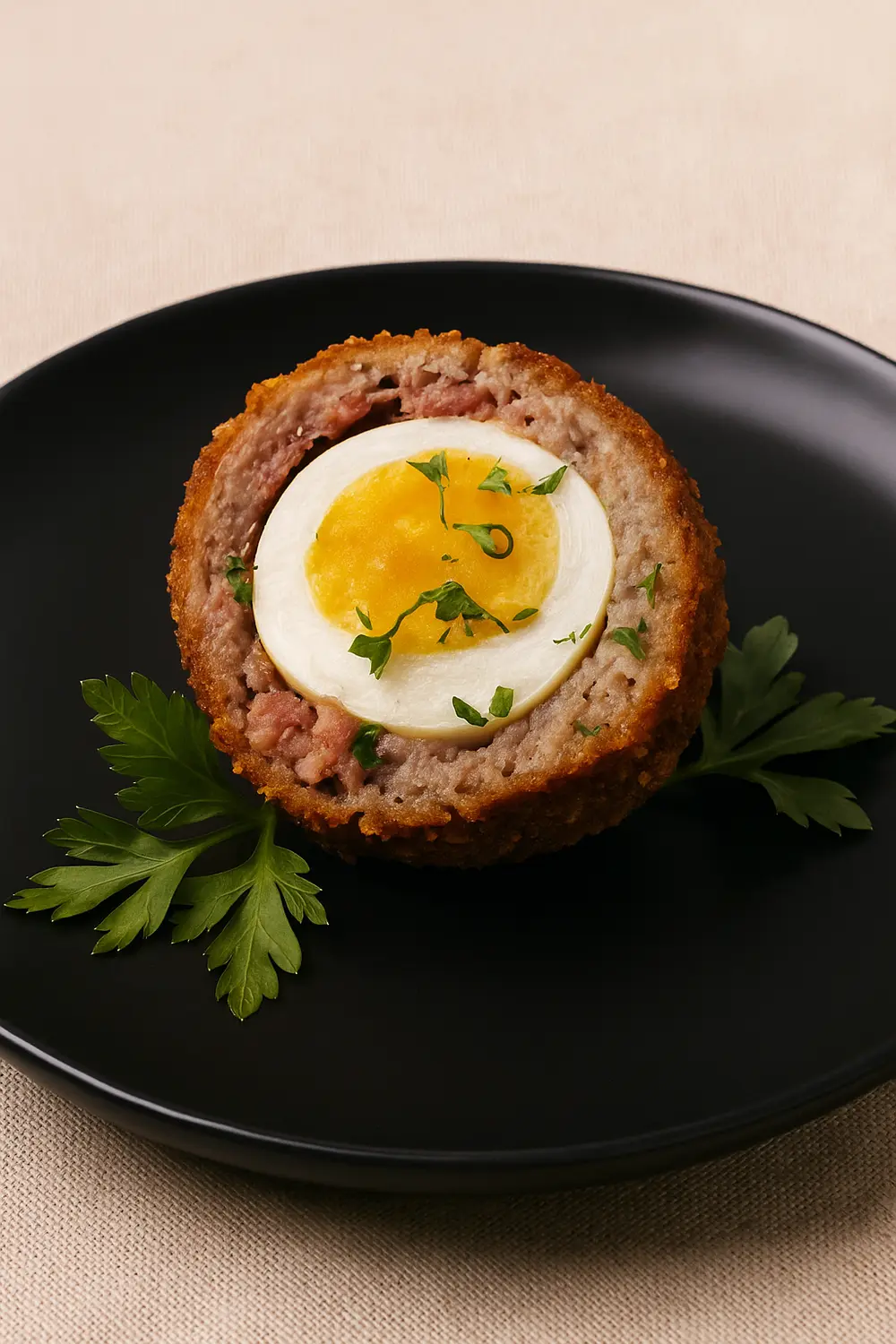
Quick Tips for Making the Best Scotch Eggs
Achieving the perfect scotch eggs consistently relies on understanding a few key principles and techniques. These are the golden rules for consistent success:
1. Get the Yolk Doneness Right
- For a luscious, jammy yolk, boiling the eggs for 6 to 7 minutes is ideal.
- A softer, runnier center can be achieved in 4 to 5 minutes.
- Firmer, hard-boiled yolk requires 8 to 10 minutes of cooking time.
2. Use Slightly Older Eggs
- Counterintuitive as it may seem, eggs that are approximately a week or two old are considerably easier to peel than very fresh ones.
- This is because older eggs have a slightly higher pH, which causes the egg white to adhere less strongly to the inner membrane, allowing for smoother peeling.
3. Don’t Skip the Ice Bath
- Immediately plunging hot, cooked eggs into an ice bath is a critical step.
- This rapid cooling halts the cooking process, preventing overcooked, rubbery whites and the undesirable green ring around the yolk.
- It also helps the egg contract slightly, further aiding in effortless peeling.
4. Pat Eggs Dry
- Before attempting to wrap the eggs in sausage, pat the eggs to ensure they are completely dry after peeling.
- Any moisture on the egg’s surface will create a barrier, preventing the sausage meat from adhering properly and potentially leading to the sausage slipping off during cooking.
5. Keep the Sausage Layer Thin & Even
- Aim for a sausage layer that is just thicker than an eighth of an inch (approximately 3-5mm).
- A layer that is too thick can overwhelm the delicate egg, creating a “sausage ball with egg” rather than a balanced scotch egg.
- Conversely, a layer that is too thin might crack during cooking, exposing the egg.
- Flattening the sausage between two pieces of plastic wrap can greatly assist in achieving this uniform thickness.
6. Chill Before Cooking
- Refrigerating the wrapped and breaded scotch eggs for at least 20-30 minutes before cooking is a highly recommended step.
- This chilling period allows the sausage meat to firm up and the breading to set securely, significantly reducing the risk of the layers falling apart during frying or baking.
7. Monitor Oil Temperature (if frying)
- If deep frying, using a thermometer to maintain the oil temperature between 350-375°F (175-190°C) is absolutely crucial.
- Oil that is too cool will lead to greasy, oil-soaked eggs, while oil that is too hot will cause the breading to burn before the sausage has a chance to cook through.
8. Do Not Overcrowd the Pan/Basket:
- When cooking, whether deep frying, baking, or air frying, work in batches of 2 to 3 scotch eggs.
- Overcrowding the cooking vessel can drastically lower the temperature, resulting in uneven cooking and a less crispy exterior.
9. Food Safety First
- Always ensure the internal temperature of the sausage reaches 160°F (71°C) using an instant-read thermometer.
- This is a critical step for food safety, ensuring the meat is thoroughly cooked.
What to Serve or Pair With Scotch Eggs
Scotch eggs are incredibly versatile and can be enjoyed in many ways, whether warm or cold. Here are some delightful serving and pairing suggestions:
- Tangy Mustard or Aioli: A dab of coarse mustard or garlic aioli cuts through richness.
- Sweet Chutney or Piccalilli: Fruity or pickled accents balance savory flavors.
- Fresh Green Salad: Peppery arugula or crisp mixed greens lighten the plate.
- Roasted Potatoes or Fries: Classic pub sides that complement the hearty egg.
- Cold Ale or Iced Tea: Refreshing beverages that wash down every savory, crunchy bite.
Final Remarks
Making homemade scotch eggs is a joyful nod to British culinary tradition with room for your creative spin.
From mastering the precise boil of the egg to experimenting with baked, fried, or air fryer methods, you’ll discover that the process is as rewarding as the results are delicious.
Whether you’re whipping up a batch for a picnic, elevating your appetizer menu, or simply craving a hearty snack, these healthy scotch eggs deliver on flavor, texture, and nostalgia.
So gather your ingredients, preheat your oven (or oil), and let the kitchen adventures begin.
Cheers to healthy eating.
Easy Homemade Scotch Eggs Recipe
This easy Scotch eggs recipe serves six and delivers perfectly seasoned sausage casings with a crispy exterior and a luscious jammy yolk at the center, an irresistible British snack classic for any occasion.
Ingredients
For the Eggs
For the Sausage Meat
For the Breading Station
For Cooking (Deep Frying Method)
How to Make Scotch Eggs (Step-by-Step Instructions)
Boil the Eggs for a Jammy Yolk
- Carefully place 6 large eggs into a saucepan.
- Fill the pan with cold water, ensuring the eggs are covered by at least an inch.
- Bring the water to a rolling boil over high heat.
- Once boiling, immediately remove the pan from the heat, cover it with a lid, and let the eggs sit in the hot water for a precise duration.
- For a beautiful jammy yolk, as often seen in ideal scotch egg presentations, aim for 6 to 7 minutes.
- For a softer, runnier yolk, a shorter time of 4 to 5 minutes is recommended.
- For a firmer, traditional hard-boiled yolk, allow 8 to 10 minutes.
Chill the Eggs in an Ice Bath
- Immediately transfer the cooked eggs to a large bowl filled with ice water.
- Allow them to cool completely for at least 5 to 10 minutes.
- This ice bath rapidly halts the cooking process to prevent the green ring around the yolk and helps the shell separate for easier peeling.
Peel and Dry the Eggs
- Once cooled, gently peel the eggs.
- Peeling them under a slow stream of cold running water can often assist the shell in sliding off more easily.
- After peeling, pat the eggs completely dry with paper towels.
- This drying step is essential, as any residual moisture on the egg surface will prevent the sausage meat from adhering properly in the next stage.
Mix the Sausage and Seasonings
- In a large mixing bowl, combine the bulk pork sausage with the garlic powder, onion powder, dried thyme, dried oregano, paprika, salt, black pepper, and fresh parsley.
- Add Worcestershire sauce and Dijon mustard for added depth and tang.
Gently Combine the Sausage Mixture
- Using clean hands, gently mix the ingredients until they are just combined.
- Avoid overmixing the sausage, as this can lead to a tough and dense texture in the final product.
- If the sausage mixture feels excessively loose or wet, add 1 tablespoon of all-purpose flour or cornstarch.
Portion and Flatten the Sausage
- Divide the seasoned sausage mixture into 6 equal portions.
- The exact number will depend on the size of the eggs and the desired thickness of the sausage layer, typically about 2 to 3 ounces (60-85g) per egg.
- Roll each portion into a ball and then flatten it into a thin, even patty (approximately 1/4 inch thick or 5mm) will significantly simplify the wrapping process and ensure uniform cooking.
Set Up the Breading Station
- Prepare three shallow bowls or dishes and arrange them side-by-side on a work surface.
- Bowl 1 contains all-purpose flour.
- Bowl 2 contains two large eggs, whisked until frothy to create an effective egg wash.
- Bowl 3 contains Panko breadcrumbs, which are highly recommended for their superior crispiness, or use regular seasoned breadcrumbs if preferred.
Dust the Eggs with Flour
- Lightly dust each peeled and thoroughly dried egg in the flour from Bowl 1, gently shaking off any excess.
- This initial thin layer of flour creates a slightly tacky surface that helps the sausage meat adhere more effectively.
Wrap the Egg in Sausage
- Place one flattened sausage patty on a piece of plastic wrap.
- A few drops of water on the plastic wrap can help prevent the meat from sticking.
- Place the floured egg in the middle of the sausage patty.
- Using the plastic wrap to assist, gently bring the edges of the sausage up and around the egg, completely encasing it.
- Carefully mold and smooth the sausage around the egg, ensuring there are no bare spots or cracks, and that the thickness of the sausage layer is as even as possible.
- Wetting your hands slightly can also aid in this process, preventing the meat from sticking to your fingers.
Triple Bread Your Scotch Eggs
- Once wrapped, gently roll the sausage-encased egg in the flour from Bowl 1 again, shaking off any excess.
- Then, dip the floured egg into the beaten egg from Bowl 2, allowing any excess egg wash to drip off.
- Finally, roll the egg thoroughly in the Panko breadcrumbs from Bowl 3, gently pressing the crumbs to ensure a thick, even, and complete coating.
- This triple-dredging method ensures a robust and crispy crust.
Chill the Scotch Eggs
- Place the breaded scotch egg on a plate or baking sheet and repeat the process with the remaining eggs.
- For optimal results and to prevent the sausage from falling apart during cooking, it is highly recommended to refrigerate the breaded scotch eggs for at least 20 to 30 minutes.
- This chilling period allows the meat to firm up and the breading to adhere securely, ensuring structural integrity during cooking.
Option 1: Deep Fry the Scotch Eggs
- In a deep, heavy-bottomed pot or Dutch oven, heat 3 to 4 inches of neutral oil (such as vegetable or canola oil) to 350°F (175°C).
- Use a candy thermometer or an instant-read thermometer to monitor the temperature.
- Oil that is too hot will burn the breadcrumbs before the sausage cooks, while oil that is too cool will result in greasy, soggy eggs.
- Carefully lower 2 to 3 scotch eggs into the hot oil using a slotted spoon, taking care not to overcrowd the pot.
- Overcrowding can significantly drop the oil temperature, leading to uneven cooking and a greasy texture.
- Fry for 5 to 7 minutes, turning occasionally to ensure even browning, until the coating is deep golden brown and crispy.
- The sausage must be thoroughly cooked, with an internal temperature reaching at least 160°F (71°C) for food safety.
- Remove the scotch eggs with a slotted spoon and place them on a wire rack set over a paper towel-lined baking sheet to drain any excess oil.
- Season lightly with salt immediately after removing them from the oil to enhance flavor.
Option 2: Bake the Scotch Eggs
- Preheat the oven to 400°F (200°C).
- Place the breaded scotch eggs on a wire rack set on a baking sheet.
- Lightly spray them evenly with non-stick cooking spray or brush with a small amount of oil, for browning and crispiness.
- Bake for 25 to 30 minutes, flipping them halfway through the cooking process to ensure even browning and crispiness on all sides.
- The internal temperature of the sausage must reach at least 160°F (71°C) for food safety.
Option 3: Air Fry the Scotch Eggs
- Preheat the air fryer to 400°F (200°C).
- Lightly spray the air fryer basket with non-stick cooking spray.
- Place the breaded scotch eggs in the basket in a single layer, ensuring they do not touch to allow for proper air circulation and even cooking.
- Lightly spray the eggs themselves with cooking spray to aid in crisping.
- Air fry for 12 to 14 minutes, flipping halfway through the cooking time.
- If the breadcrumbs appear dry during cooking, an additional light spray of oil can be applied.
- The internal temperature of the sausage should reach at least 160°F (71°C).
Cool and Slice the Scotch Eggs
- Allow the scotch eggs to cool for a few minutes after cooking.
- This brief resting period helps the internal structure settle.
- Slice them in half with a serrated knife; the serrated edge helps prevent squishing the yolk and maintains the integrity of the layers.
- Garnish with fresh herbs like finely chopped parsley or chives.
Serve and Enjoy
- Serve warm or at room temperature.
- Scotch eggs are excellent with a variety of dipping sauces, such as a tangy mustard, a sweet honey mustard, or even classic ketchup.
Nutrition Facts
Servings 6
Serving Size 1 Scotch Egg (approx. 113g)
- Amount Per Serving
- Calories 258kcal
- % Daily Value *
- Total Fat 14.6g23%
- Saturated Fat 3.9g20%
- Trans Fat 0.3g
- Cholesterol 193mg65%
- Sodium 200mg9%
- Potassium 210mg6%
- Total Carbohydrate 8g3%
- Dietary Fiber 1g4%
- Sugars 0.8g
- Protein 15g30%
- Vitamin A 313 IU
- Vitamin C 2 mg
- Calcium 32 mg
- Iron 2 mg
* Percent Daily Values are based on a 2,000 calorie diet. Your daily value may be higher or lower depending on your calorie needs.
Note
- Always use an instant-read thermometer to confirm the sausage reaches an internal temperature of 160°F (71°C) for food safety, regardless of the cooking method.
- After boiling, immediately transfer eggs to an ice bath to stop cooking and aid peeling.
- When forming sausage patties, aim for an even thickness (approx. 1/4 inch or 5mm) around the egg to ensure uniform cooking and prevent cracking.
- Refrigerate the wrapped and breaded eggs for 20–30 minutes to firm up the meat and set the breading so they hold together perfectly when cooked.
- If deep frying, keep the oil at 350–375°F (175–190°C) with a thermometer to ensure a crispy exterior and fully cooked interior without greasiness or burning.
- Cook scotch eggs in small batches (2-3 at a time) to maintain consistent cooking temperature and allow for even browning and crisping.

